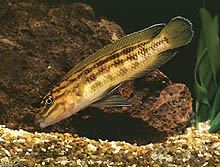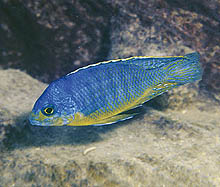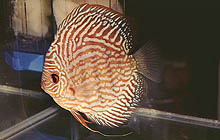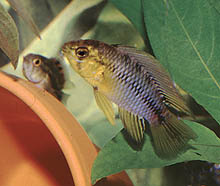WHAT'S NEW ACROSS THE WORLD
What's
new April 2000
What's
new July 2000
What's
new October 2000
What's
new January 2001
What's
new April 2001
What's
new July 2001
What's
new October 2001
What's
new January 2002
What's
new April 2002
What's
new July 2002
What
is new October 2002
| What's New ©by
Laif DeMason
Winter’s ice and snow have made their annual appearance
in the northern hemisphere marking the change in seasons. Along with
this change in weather comes an increased interest in cichlids. Exporters
and breeders alike have seen a surge in sales over the last month after
a slow autumn. Collectors are actively seeking new items, while specialty
importers have diversified into different varieties of fishes. Hobbyists
are also looking into different cichlid groups for new challenges or just
for a change of pace. Hopefully, those who venture away from cichlids
altogether will find their way back. Meanwhile newcomers are finding
fascination and pleasure in the family Cichlidae!
Here’s “what’s new” on the cichlid scene: |
Lake Tanganyika
Collections and exports from Burundi, Tanzania, and Zambia are in full
swing. Due to increased competition, collectors in Zambia are especially
active in finding different items (though sometimes the differences are
in name only!). Congo collections are still sputtering, although
there is talk of increased access. Tanganyikan cichlids are gaining
popularity over their Malawi counterparts in the United States. However
this is not true in Europe and elsewhere.
|
what's new: Lake Tanganyika
|

Cyphotilapia frontosa with blue coloration
exist everywhere in the southern third of Lake Tanganyika. Due to
the limited access to the famous Kapampa Congo variety, collectors continue
to look for the bluest substitutes. Here a very blue “Kipanga” form.
|

Exported from Zambia, this new red form of Altolamprologus
compressiceps is sold as “fire fin”. |

Somewhat smaller than other wild populations of Neolamprologus
brichardi, this dwarf form hails from Karilani Island, Tanzania. |

Also from Karilani Island, this Julidochromis
species is sold as “orange marlieri”. |

A fish reportedly caught in the Congo, Neolamprologus
helianthus is now being bred and exported as adults from Zambia. |

Exported from Zambia, a new form of Ophthalmotilapia
nasuta is marketed as “gray leopard”. |
Lake Malawi
Collections and exports from Tanzania, Malawi, and, to a lesser extent,
Mozambique are per normal. Commercial breeders of Malawi cichlids, especially
in the Far East, have overproduced and thus lowered prices. The resulting
effect has made serious Malawi hobbyists lose some interest in keeping
wild-caught specimens. Wise hobbyists will choose their Malawi cichlid
fishes carefully.

Caught in Sanga Bay (Malawi), this new Aulonocara
variety sports a white margin to the dorsal fin. |

This jumbo variety of red-top Cynotilapia afra
hails from Londo, Mozambique. |

One of the many “Chilumba” types of Labeotropheus
trewavasae, this one from Tumbi Reef in Tanzania has red-ochre males
with OB females. |

Sold as Protomelas “steveni yellow chin,” this
form from Pombo Reef (Tanzania) is one of the most beautiful with yellow
that extends onto the face. Photo by A. Konings. |
Non-rift Africa
Both re-sellers and hobbyists are looking for something other than the
“norm” in African cichlids. Many have tried their hands at fishes from
Cameroon and other oddities from West Africa. Re-visiting this exciting
and often neglected fauna has proved rewarding for that needed change of
pace!
|
what's new: Non-Rift Africa
|

Formerly known as Chromidotilapia finleyi Moliwe
(Cameroon), this fish has now been re-classified as Benitochromis nigrodorsalis. |
 From the southeast (Maralambo) area of Madagascar, the rarely-seen Ptychochromoides
katria has now been bred in captivity.
From the southeast (Maralambo) area of Madagascar, the rarely-seen Ptychochromoides
katria has now been bred in captivity. |
Neotropics
December marks the beginning of the collecting season in Brazil as well
as elsewhere in South America. Discus, pike cichlids, and geophagines,
as well as dwarf cichlids, are the general import fare for dealers. Neotropical
buffs keep searching and finding new varieties to breed, usually from private
collecting expeditions. Keep in touch with the specialty breeders/dealers
for the latest!

Imported from Peru, the red morph of the pike cichlid,
Crenicichla cincta, has unique vertical bars and very large size.
Photo by J. Rapps. |

Native to Panama and growing to 10" in length, Amphilophus
lyonsi is infrequently offered by specialty breeders. Photo by
J. Rapps. |

Commercially-bred in the Far East, this heckel-type
Symphysodon discus sports the selected traits of a high body form
and distinctive striations. |

Commercially-bred dwarf cichlids, like this Apistogramma
borellii, are becoming popular residents in well-planted aquariums. |
|











 From the southeast (Maralambo) area of Madagascar, the rarely-seen Ptychochromoides
katria has now been bred in captivity.
From the southeast (Maralambo) area of Madagascar, the rarely-seen Ptychochromoides
katria has now been bred in captivity.


